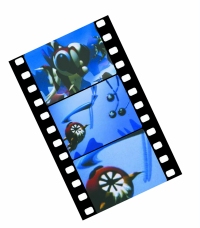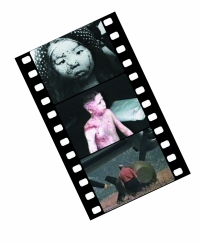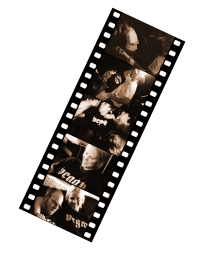
VOL. 10 NO. 3 THE MAGAZINE OF THE UNIVERSITY OF UTAH WINTER 2000
Continuum
Home Page - University of Utah Home
Page - Alumni Association
Home Page
Questions, Comments -
Table of Contents
Celluloid Heroes
The Film Studies Division grows from a single course to one of the top programs in the country.
by Mary Dickson
Photos By Brad Nelson
Illustration By Randall Royter
Every winter, filmmakers, film lovers, and film students from around the world converge on the snowy streets of Park City, Utah, for what has become one of the most highly regarded film festivals in the world. Utah is also increasingly used by major-league filmmakers as a locale for their films. What better place, then, for a program that trains students in the art of filmmaking?
 Housed
in the University's College of Fine Arts, the Film Studies Division has
emerged as one of the top 20 film schools in the country. "People
come from all over the planet to study here," says Brian Patrick,
who heads the production side of the division, "not just because
of us, but because the Sundance Institute and the Sundance Film Festival
help to draw students. Slowly but surely, after 22 years, the right elements
have come together."
Housed
in the University's College of Fine Arts, the Film Studies Division has
emerged as one of the top 20 film schools in the country. "People
come from all over the planet to study here," says Brian Patrick,
who heads the production side of the division, "not just because
of us, but because the Sundance Institute and the Sundance Film Festival
help to draw students. Slowly but surely, after 22 years, the right elements
have come together."
Last year, film studies split from the Departments of Art and Theatre to become its own entity with an official designation as a "division." "We're not a department yet, but we're treated like a department," says Patrick. "We have control over our own destiny. It's really an exciting time for us." The division has its own budget and four faculty members-chair William Siska and Tom Sobchack, who teach film history, theory, and criticism; and associate chair Brian Patrick and Kevin Hanson MFA'84, who teach on the production side. A number of adjunct faculty, including actor/director Robby Benson, who teaches screenwriting and film and television directing, fill out the division.
"It's the most wonderful place to learn," says Benson. "I feel so lucky to work with Brian Patrick and Bill Siska. And I adore the students—they're so bright. I feel honored to be part of the system."
The program offers students something few other film schools do. "Every student has a chance to make a film," says Jan Andrews BA'71 MA'72 MFA'98, an award-winning Utah filmmaker who studied in the program and now teaches courses there. "It's not like the big schools—UCLA, USC, and NYU—where you're lucky to be a grip. Everyone who gets into the program and film production classes can make a film."
And many of them, including Andrews, have done it very well. Casey Williams MFA'93 won a student Academy Award for Ginbachasue, his very personal film on his father's experiences in Nagasaki after the H-bomb was dropped. The film, which was first broadcast on KUED-Channel 7, has been shown internationally in France, Russia, and Japan. Alex Beckstead's film on straight-edgers, sXe, was shown at the Sundance Film Festival in 1999. Beckstead, who made the film as part of his honors thesis at the University, is now working with KUED on a film about the "last great Western wagon train," composed of people like his grandparents who hit the road in mobile homes after retirement. Rhea Gavrey's film, Promise Not to Tell, chronicling a controversial Lehi sex abuse case, was accepted for national broadcast on PBS's P.O.V. series, which showcases the best of American independent film. Mel Halbach MFA'97 has had success with his film about the women soldiers in Vietnam, Long-Haired Warriors, and Annie Kocherhans BA'92 has won a number of prizes, as have Judy Voye ex'83, Jill Gibbons, and others.
Two students-most recently Dylan Dow MFA'97-have won a major scriptwriting contest that is a subsidiary of the Academy Awards in Los Angeles. The division's most recent success is a computer animation film, Fish Wars, that won a number of awards, including one at Sundance. The film was made by four students who worked with faculty advisor Dale Angel. "That film put us on the map because computer animation has become such a thrilling art form," says Patrick, noting that the division has added computer animation classes to meet a growing need.
 "We've
had many successful people come out of our program," echoes faculty
member Tom Sobchack, whose own film reviews are heard on KUER public radio.
Faculty, who realize what a competitive world filmmaking is, don't pretend
that graduates will end up the next Steven Spielberg. Their names may
very likely show up in film credits, but they'll never become household
words.
"We've
had many successful people come out of our program," echoes faculty
member Tom Sobchack, whose own film reviews are heard on KUER public radio.
Faculty, who realize what a competitive world filmmaking is, don't pretend
that graduates will end up the next Steven Spielberg. Their names may
very likely show up in film credits, but they'll never become household
words.
"A lot of people want to get into film school because they want to go to Hollywood and make dramatic films," says Patrick. "It's their dream to be like Spielberg, who rose from nothing to be one of the most well-considered filmmakers around. Ultimately our students end up going into documentaries, which are easier to make and fund. That's where they win awards."
Adds Sobchack, "Bill Siska [the division's chair] likes to say that any graduate who wants to work has the qualification to get a job somewhere if he or she is persistent enough.
"We've had some working in Hollywood, while others work in local television. Some have their own production companies. Some end up making commercials. Some undergraduates go on to do graduate work at other schools."
 Most
graduates end up staying in some aspect of film, becoming assistant directors,
script supervisors, set designers or editors, or production supervisors.
Siska is trying to start an alumni program so that students can network
with graduates in the industry. But Patrick stresses that the program
isn't set up to feed people into the industry. "Our real emphasis
is on independent filmmaking in the total sense of the word," he
says. "Hollywood film schools like UCLA that feed the industry generally
force students to emphasize one particular area. We're too small for that.
We want people to come out of here with a broad understanding of how to
make movies, whether it be documentary or narrative filmmaking. They'll
know how to deal with film, with video, with computer technology. We're
very proud that we teach them all of that."
Most
graduates end up staying in some aspect of film, becoming assistant directors,
script supervisors, set designers or editors, or production supervisors.
Siska is trying to start an alumni program so that students can network
with graduates in the industry. But Patrick stresses that the program
isn't set up to feed people into the industry. "Our real emphasis
is on independent filmmaking in the total sense of the word," he
says. "Hollywood film schools like UCLA that feed the industry generally
force students to emphasize one particular area. We're too small for that.
We want people to come out of here with a broad understanding of how to
make movies, whether it be documentary or narrative filmmaking. They'll
know how to deal with film, with video, with computer technology. We're
very proud that we teach them all of that."
To Andrea Robison, a senior in the program, the hands-on experience is invaluable. "Trying to direct your own film gives you a whole conception of what it means to be a filmmaker," she says. "The professors have experience in producing different types of films, which allows them to cater to students who want to create a variety of styles of work. Students use their visual knowledge to create unusual and individualistic pieces of art instead of typical Hollywood-type films."
Robison also has been impressed with the exposure to international cinema. "They're addressing films from around the globe, which gives a much larger picture of what film is," she says. "What the department is lacking is a woman to address women's roles in film. Things are always different from a female perspective. I realize this isn't a female-dominated industry, but women and women's issues are making their way into film more and more." Robison would like to see the department recruit more female instructors and students. "In the four years I've been here, I've seen an increase, but in my screenwriting class, there are 17 students and only three are women."
Just as important as the hands-on production classes are courses that provide a solid grounding in film history, theory, and criticism. "The theory, criticism, and history side helps students become better filmmakers because it gives them models of the best films that have been made," says Sobchack. "It lets them absorb a tradition. T.S. Eliot always said that poets are readers of poetry. They know the tradition. They know the past. That's what we get out of our undergraduate filmmakers, most of whom complete 16-millimeter films. If they were just doing production, they wouldn't be as likely to make something really splendid, because they wouldn't have absorbed the sense of aesthetic principles."
Even the division's master's program, which is essentially a studio degree, creates better filmmakers. "Some of them haven't been steeped in the material that we give to our undergraduates," says Sobchack. "We require them to have film history and seminars in film criticism and theory. Overall, the two-pronged approach of production with film history and criticism is complementary and leads to better films."
Film studies began in 1967 when Sobchack, who was in the English department, and a couple of professors from the Department of Languages and Literature taught an "Introduction to Film" course. Soon, the English department added international and foreign film courses. "Introduction to Aesthetics," "American Genres," and "Ideas in Cinema" followed.
 In
1977 Bill Siska was hired in the theatre department and given the mandate
to set up a film program that would be part of the art and theatre departments.
Brian Patrick, who joined the U faculty in 1978, taught production courses
and kept all of the program's equipment in his tiny office in the art
department. Sobchack continued teaching courses through the English department.
More and more students enrolled in the film classes offered through those
three departments, which were conferring a lot of Bachelor of University
Studies degrees to film students. "Once you look at the numbers of
students we had enrolled in classes, we had a program," says Sobchack.
By 1983 the University had created an interdepartmental Bachelor of Arts
degree program to accommodate all the students clamoring for film degrees.
"Our students had accrued lots of credit hours with us," says
Patrick. "Ultimately the students wanted this program, and we rose
to the occasion to deliver it to them. That's how it all happened."
In
1977 Bill Siska was hired in the theatre department and given the mandate
to set up a film program that would be part of the art and theatre departments.
Brian Patrick, who joined the U faculty in 1978, taught production courses
and kept all of the program's equipment in his tiny office in the art
department. Sobchack continued teaching courses through the English department.
More and more students enrolled in the film classes offered through those
three departments, which were conferring a lot of Bachelor of University
Studies degrees to film students. "Once you look at the numbers of
students we had enrolled in classes, we had a program," says Sobchack.
By 1983 the University had created an interdepartmental Bachelor of Arts
degree program to accommodate all the students clamoring for film degrees.
"Our students had accrued lots of credit hours with us," says
Patrick. "Ultimately the students wanted this program, and we rose
to the occasion to deliver it to them. That's how it all happened."
A small student-teacher ratio is particularly attractive to students, as is the opportunity to meet prominent filmmakers brought in for special lectures. In recent years, director Norman Jewison, German filmmaker Werner Herzog, and documentary filmmaker Jon Else have visited campus. Students also get a chance to work and attend seminars at the Sundance Film Festival and to take a class in Sundance films so that they can see what's current in the world of independent filmmaking, especially at the entry level.
Given the popularity of film in modern culture, it's not surprising that the Film Studies Division can be selective in admitting students. The division, which has about 200 undergraduates and 15 graduate students, accepts only three to five graduate students of the 40 to 50 who apply each year. "We don't necessarily want someone who has had a film class," says Patrick. "We like people who can write, who have good ideas, and who come from other disciplines. The most important thing we look for is their potential."
Fabian Retrovan, who comes from a small village in the mountains of Ecuador, was a student whose potential the department recognized. He started in computer science and made the conversion to film. "He had an analytical mind that he transferred into a kind of aesthetic process," says Patrick. Retrovan produced an insightful, impressionistic documentary that spoke to issues of overpopulation and drew on the roots of his native legacy. He brought a depth of understanding to the human condition that few students are capable of achieving.
What's most important to the men running the program is that students have a visual understanding and literacy to accompany their desire to make films. Students are required to take a production course in which they produce a five-minute documentary showing that they can translate an idea into a motion picture. Technical brilliance doesn't necessarily make the grade. "It's almost better that they have great ideas," says Patrick. "We'll show them how to do the rest. This isn't a technical school; we teach the technical in the context of the aesthetic idea."
The broad approach is in some ways a salve to the more fickle tastes of filmgoers. "In the beginning, around the 1970s, students were still responding to different kinds of movies that made important statements about culture, politics, and society, or that were clever, witty, and playing with the aesthetics of narrative," says Sobchack. "As the 1970s proceeded to fade, you began to get people impressed by Star Wars, The Godfather, and E.T. They were responding to the spectacular blockbuster film and seeing it as an extraordinary, powerful medium in which one could find fame and fortune. We began to get people mostly interested in production."
Today, with students interested in, and versed in, all dimensions of film, the faculty is proud that it has done so much with so little. "What we've created is a very attractive program in film studies," says Patrick. "As Utah is put on the filmmaking map, we have been able to rise to the challenge of keeping it there."
—Mary Dickson, who wrote about the Classical Greek Theatre Festival in the Fall 2000 Continuum, is director of creative services at KUED-Channel 7. She also writes a weekly cinema column for City Weekly in Salt Lake City.
Continuum Home Page - University of Utah Home Page - Alumni Association Home Page
Questions, Comments - Table of Contents
Copyright 2001 by The University of Utah Alumni Association